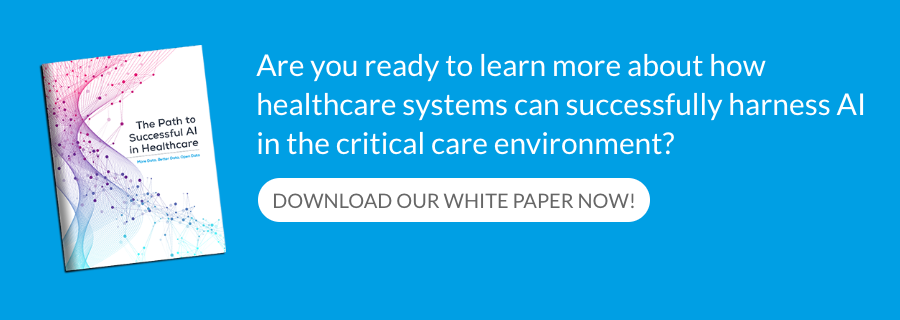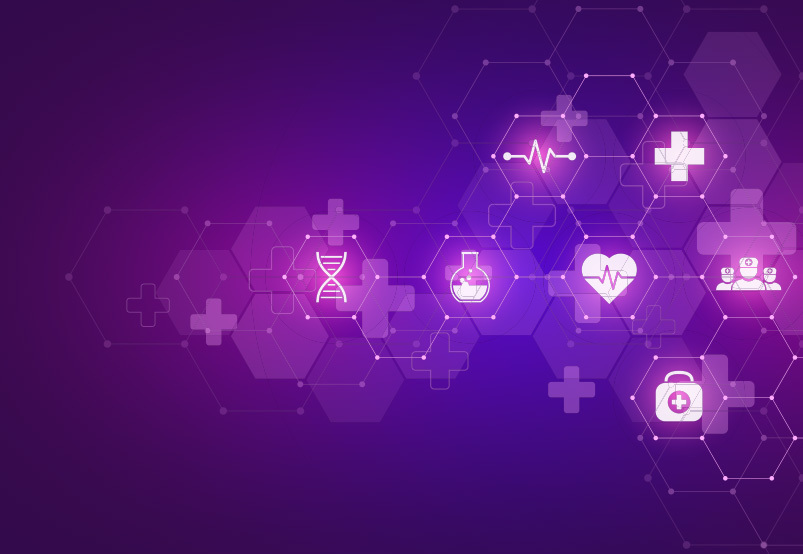
The ability to truly change healthcare has been locked away for years. Even more frustrating is that it has been locked away in plain sight – right next to the very patients it is supposed to help us save.
Caregivers have been desperate to put the science of data to work for them as they make decisions that can have life-or-death impact on patients. Up until now, the data needed has been available only in trickles here and there, for the most part is retrospective, and is often subject to error from human interpretation and manual input.
As Geoffrey Moore, consultant and author of Crossing the Chasm, proclaimed: “Without ‘big data,’ you are blind and deaf and in the middle of a freeway.”
Is that where we want the people who are trying to save our lives – blind and deaf in the middle of a freeway?
Big Data in Healthcare
No one can argue that healthcare data, specifically patient data, is probably the most valuable data we have. And it’s not that we don’t have patient data. In fact we are drowning in it.
If you look at critical care environments where we have the sickest of the sick patients, they generate over 800,000 samples of data every hour. And that’s just from the bedside monitoring devices. When you combine that with all the data from the EMR, labs, meds, imaging, data lakes and more the volume is not the issue. As Eric Topol expresses in his book Deep Medicine: How Artificial Intelligence Can Make Healthcare Human Again, the issue is that only five percent of that data is actually processed and available to support clinical care. “In a sense, it was all dressed up, with nowhere to go,” he writes.
This data set is a clear example of “Big Data” because the factors that distinguish it from smaller data sets are the very dimensions that make it of value to the caregivers caring for patients, particularly patients who are critically ill. Denis Kaminsky, CEO at Arcus Global, illustrated this point in his article in Digital Leaders: "What’s the difference between ‘Big Data’ and ‘Data’?"
There are “dimensions” that distinguish data from BIG DATA, summarized as the “3 Vs” of data: Volume, Variety, Velocity. Hence, BIG DATA is not just “more” data. It is so much data, that is so mixed and unstructured, and is accumulating so rapidly, that traditional techniques and methodologies including “normal” software do not really work (like Excel, Crystal reports or similar).
Kaminsky goes on to explain Big Data as a term to summarize a set of tools, methodologies and techniques for deriving new insight from complex sample sizes, likely combining multiple datasets. Crunching this data to establish patterns and correlations would allow us to truly understand causality and, most importantly, make predictions based on fact. There really can’t be any better way than this to use patient data that we are already capturing.
However, to benefit from the data, we must analyze and crunch the data. To do that, we must first acquire it. Sounds simple but this is no easy task when the data we need from the wide and disparate volume of devices manufactured by thousands of different companies is siloed and locked down into proprietary formats.
So how do we break down those silos?
The History of Medical Device Integration (MDI)
For years, healthcare has understood how dangerous the data silos are, evidenced by medical device interoperability standards dating as far back as 1982. However, most of those standards were focused on manufacturing standards rather than connectivity to downstream systems.
As electronic medical records (EMRs) came into the mix, it was quickly realized that there was also a need to send data from bedside devices to the record, to avoid what was then a manual process of gathering patient vitals at set frequencies and then entering that information, by hand, into the EMR. The IHE initiative therefore kicked off in 2005 as a concerted effort to improve the way computer systems in healthcare share information – including devices at the bedside.
The dawn of IHE led to the need for new technology to acquire data from those bedside monitoring devices and automatically populate patient vital signs into the EMR. That technology is known as medical device integration (MDI). Realizing the power and possibility of MDI, hospitals and healthcare systems quickly adopted it to solve this manual documentation challenge.
The Need for Evolved MDI
Within the last two years however, the healthcare industry has dramatically changed. More and more hospitals and healthcare systems are merging, leading to an even more complex infrastructure of biomedical devices and systems that don’t talk to each other. We are quickly moving to a state where more remote monitoring, virtual ICUs, and telehealth are integral parts of a system’s care delivery concept. And, artificial intelligence (AI), machine learning (ML) and Internet of Medical Things (IoMT) are growing at a near light-speed pace with the promise of more advanced processing of data that can detect risk faster, save more lives, and improve the overall provider-to-patient experience.
All of these changes and advancements in technology have led to a need for medical device integration (MDI) to evolve. Specifically, providers, hospitals and healthcare systems are looking to capture data at a higher volume, variety and velocity than what is currently available with most MDI solutions. They need the high-fidelity waveform data coming off the disparate biomedical devices at the bedside — without it, remote monitoring at scale and patient-centered analytics will likely be shortchanged.
Furthermore, they need a central processor to process and store all patient data. They need a way to send that processed data back into the clinical environment for decision support and surveillance – beyond the bedside, beyond the central, beyond the walls of the hospital. They need access to all of the data, end-to-end, to enable clinical surveillance for a patient’s entire length of stay through complete patient history for as long as the hospital wants to store the data. And they need a way to access their own data to develop and deploy real-time, patient-centered analytics at scale to further reduce risk and save more lives.
Current MDI solutions simply weren’t designed to address these advancements. So, here we are again, looking for answers on how to get the data at a higher volume, variety and velocity that is needed from these siloed devices to a place beyond EMR integration and documentation and into a world of data-driven medicine and patient-centered care at scale.
The Future of MDI
There is a new solution that can address these issues that not only captures this data but also helps crunch and return the data to the front lines to be used by clinicians in the war against illness. Powered by Intel, this new secure MDI solution from MIC and technology solution leader Cisco will accelerate the deployment of new clinical surveillance tools, vendor-agnostic remote monitoring, and patient-centered AI and IoMT at scale.
MIC, Cisco, and Intel have worked together to create a first-of-its-kind integrated solution to solve this problem by optimizing Cisco’s network to enable secure medical device integration and enable the integration of waveform data back to MIC’s Sickbay platform. This powerful integration option:
- Simplifies the complexity of integration with no special hardware
- Eliminates the need for another point of integration,
- Works seamlessly with a hospital’s Cisco network,
- Reduces the cost of maintenance,
- Improves system reliability with an MDI-enabled network architecture,
- Enables secure communication (end-to-end encryption) and authentication of devices,
- Reduces the risk of breaches and cyber attacks by isolating biomedical devices running on outdated operating systems, and
- Reduces risk further with faster threat detection and medical device segmentation by adding on the Cisco Digital Network Architecture (DNA).
Where Do We Go From Here?
The opportunity that exists to alter the face of healthcare today with advanced technologies such as remote monitoring, AI, ML, and IoMT can not be denied. Yet it feels like a daunting task to review all the options, much less implement.
The integrated MIC, Cisco and Intel solution will provide the much-needed architecture to realize the vision of these technologies and to truly leverage the opportunities that exist when harnessing the volume, variety and velocity of Big Data. It will provide the foundation for data-driven medicine and patient centered-care. And, it will serve to solve the complexities that result from multi-facility, multi-vendor healthcare organizations that are trying to sort through the layers of integration needed.
We have an increasingly complex patient population, increasing demands on care, and lives are on the line. MIC, Cisco and Intel are working with each other and many other partners to break down the silos, shift the healthcare landscape, and take these technologies and processes from possibility to mission-critical.
So, where to start? By unlocking ALL of the data from the bedside devices — the ones right next to the patients we are trying to help.





